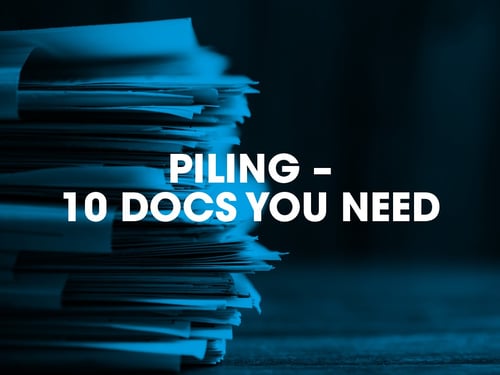Documents to submit before piling construction begins
The first five documents need to be submitted to your surveyor before piling construction begins on site. The next five documents should be submitted as soon as they become available, preferably before any further work commences over the piles.
- Desk study, investigative, and interpretive site investigation report(s)
Detail: To at least 5m below the pile toe, with associated geotechnical testing sufficient for pile design including DS / ACEC requirements for buried concrete, heave and shrinkage
- Foundation drawings, pile layouts and schedules
Detail: With pile reference numbers and loadings
- Project Structural Engineer’s specification for piling works
Detail: To include the allowable pile settlements and testing requirements
- Load calculations
Detail: Calculation to demonstrate how the load on each pile was derived
- Pile design calculation for vertical, horizontal, tensile and heave forces
Detail: To geotechnical parameters in Site Investigation Report and a copy of the pile set design (for driven piles, if applicable). This should include the pile designer’s written confirmation that the site investigation is adequate to ensure that the pile design complies with British Standards, and include confirmation, justification, type and number of any preliminary and/or working pile load tests required to satisfy the design.
Documents needed before continuing over piles
6. Pile installation logs
Detail: With pile numbers cross-referenced to the pile layout drawing, including details of re-strikes, rock sockets, rig telemetry records and concrete volume
7. Concrete mix details and cube test results for concrete used in the piles
Detail: With tabulated results similar to that in Concrete Advice Note. No.30 (The Concrete Society) Tables 1 and 3. Delivery records, cross-referenced to the pile layout/numbers, should also be kept for possible future reference
8. Integrity testing of all concrete piles
Detail: With interpretive summary and conclusion
9. Dynamic load testing results (where applicable)
Detail: With analysis of long-term settlement, interpretive summary and conclusion
10. Static load test results
Detail: with interpretive summary and conclusion
If you intend to deviate from the above guidance, contact LABC Warranty to discuss your proposals prior to commencement.
If you intend to deviate from the above guidance, contact LABC Warranty to discuss your proposals prior to commencement.
In the absence of approval, works will proceed at the developer’s own risk.

